The Cambridge History of Japan, Vol. 3: Medieval Japan
Подождите немного. Документ загружается.

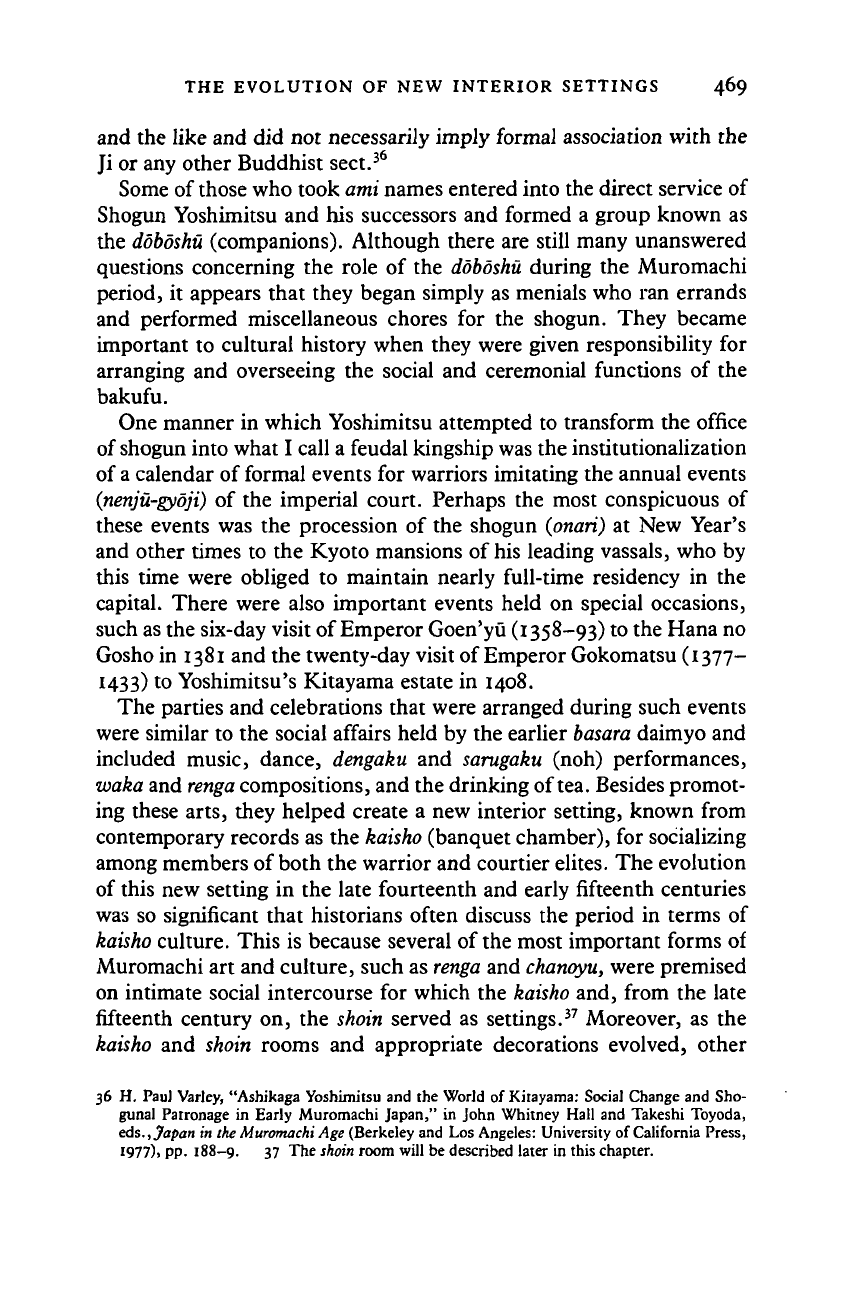
THE EVOLUTION OF NEW INTERIOR SETTINGS 469
and the like and did not necessarily imply formal association with the
Ji or any other Buddhist sect.
36
Some of those who took ami names entered into the direct service of
Shogun Yoshimitsu and his successors and formed a group known as
the
doboshu
(companions). Although there are still many unanswered
questions concerning the role of the doboshu during the Muromachi
period, it appears that they began simply as menials who ran errands
and performed miscellaneous chores for the shogun. They became
important to cultural history when they were given responsibility for
arranging and overseeing the social and ceremonial functions of the
bakufu.
One manner in which Yoshimitsu attempted to transform the office
of shogun into what I call a feudal kingship was the institutionalization
of a calendar of formal events for warriors imitating the annual events
(nenju-gydji) of the imperial court. Perhaps the most conspicuous of
these events was the procession of the shogun (onari) at New Year's
and other times to the Kyoto mansions of his leading vassals, who by
this time were obliged to maintain nearly full-time residency in the
capital. There were also important events held on special occasions,
such as the six-day visit of Emperor Goen'yu (1358-93) to the Hana no
Gosho in 1381 and the twenty-day visit of Emperor Gokomatsu (1377-
1433) to Yoshimitsu's Kitayama estate in 1408.
The parties and celebrations that were arranged during such events
were similar to the social affairs held by the earlier
basara
daimyo and
included music, dance, dengaku and sarugaku (noh) performances,
waka and
renga
compositions, and the drinking of tea. Besides promot-
ing these arts, they helped create a new interior setting, known from
contemporary records as the kaisho (banquet chamber), for socializing
among members of both the warrior and courtier elites. The evolution
of this new setting in the late fourteenth and early fifteenth centuries
was so significant that historians often discuss the period in terms of
kaisho culture. This is because several of the most important forms of
Muromachi art and culture, such as
renga
and chanoyu, were premised
on intimate social intercourse for which the kaisho and, from the late
fifteenth century on, the shoin served as settings.
37
Moreover, as the
kaisho and shoin rooms and appropriate decorations evolved, other
36 H. Paul Varley, "Ashikaga Yoshimitsu and the World of Kitayama: Social Change and Sho-
gunal Patronage in Early Muromachi Japan," in John Whitney Hall and Takeshi Toyoda,
eds.,
Japan in the Muromachi Age (Berkeley and Los Angeles: University of California Press,
I977)> PP- 188-9. 37 The shoin room will be described later in this chapter.
Cambridge Histories Online © Cambridge University Press, 2008
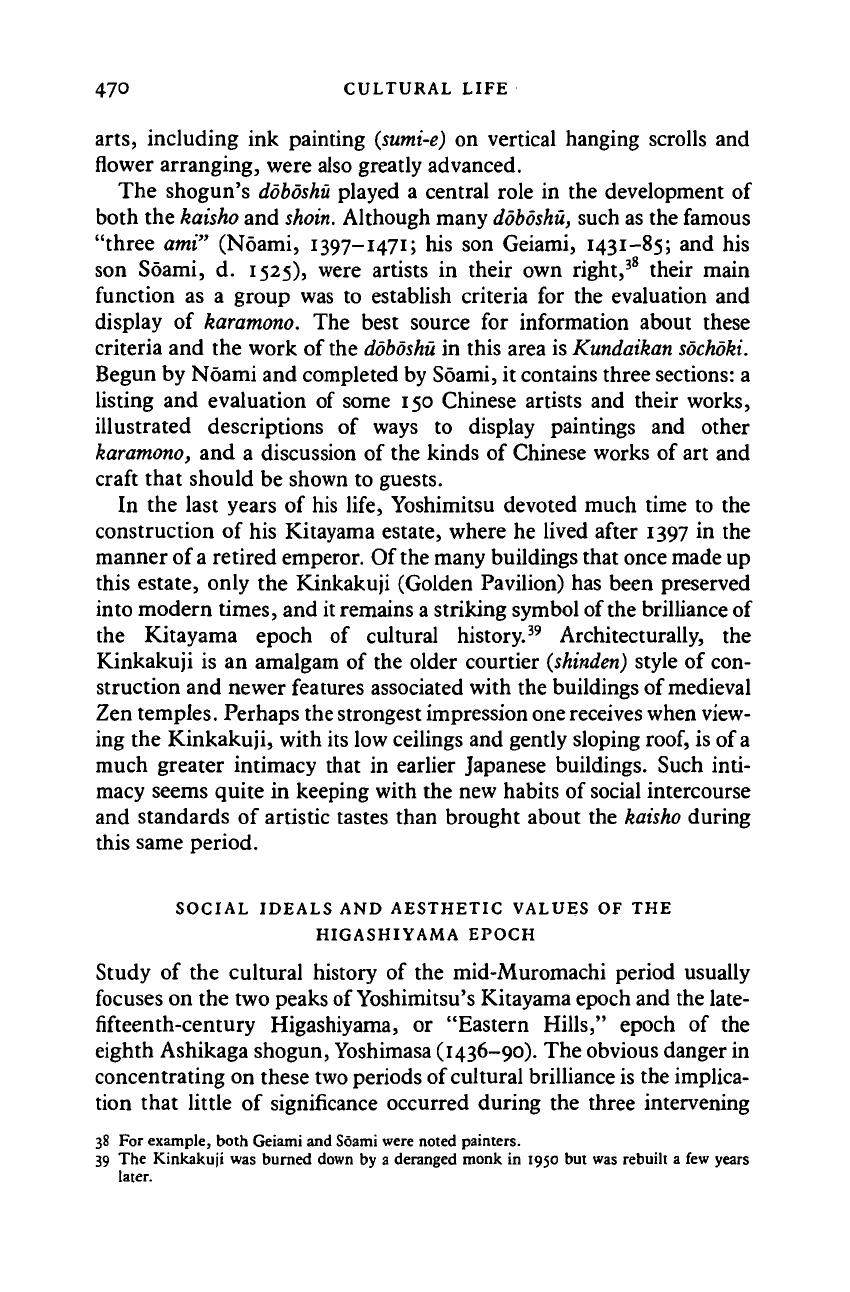
470 CULTURAL LIFE
arts,
including ink painting
(sumi-e)
on vertical hanging scrolls and
flower arranging, were also greatly advanced.
The shogun's
doboshu
played a central role in the development of
both the
kaisho
and
shoin.
Although many
doboshu,
such as the famous
"three ami" (Noami, 1397-1471; his son Geiami, 1431-85; and his
son Soami, d. 1525), were artists in their own right,
38
their main
function as a group was to establish criteria for the evaluation and
display of
karamono.
The best source for information about these
criteria and the work of the
doboshu
in this area is
Kundaikan
sochoki.
Begun by Noami and completed by Soami, it contains three sections: a
listing and evaluation of some 150 Chinese artists and their works,
illustrated descriptions of ways to display paintings and other
karamono,
and a discussion of the kinds of Chinese works of art and
craft that should be shown to guests.
In the last years of his life, Yoshimitsu devoted much time to the
construction of his Kitayama estate, where he lived after 1397 in the
manner of a retired emperor. Of the many buildings that once made up
this estate, only the Kinkakuji (Golden Pavilion) has been preserved
into modern times, and it remains
a
striking symbol of the brilliance of
the Kitayama epoch of cultural history.
39
Architecturally, the
Kinkakuji is an amalgam of the older courtier
(shinden)
style of con-
struction and newer features associated with the buildings of medieval
Zen temples. Perhaps the strongest impression one receives when view-
ing the Kinkakuji, with its low ceilings and gently sloping
roof,
is of
a
much greater intimacy that in earlier Japanese buildings. Such inti-
macy seems quite in keeping with the new habits of social intercourse
and standards of artistic tastes than brought about the
kaisho
during
this same period.
SOCIAL IDEALS AND AESTHETIC VALUES OF THE
HIGASHIYAMA EPOCH
Study of the cultural history of the mid-Muromachi period usually
focuses on the two peaks of Yoshimitsu's Kitayama epoch and the late-
fifteenth-century Higashiyama, or "Eastern Hills," epoch of the
eighth Ashikaga shogun, Yoshimasa (1436-90). The obvious danger in
concentrating on these two periods of cultural brilliance is the implica-
tion that little of significance occurred during the three intervening
38 For example, both Geiami and Soami were noted painters.
39 The Kinkakuji was burned down by a deranged monk in 1950 but was rebuilt a few years
later.
Cambridge Histories Online © Cambridge University Press, 2008
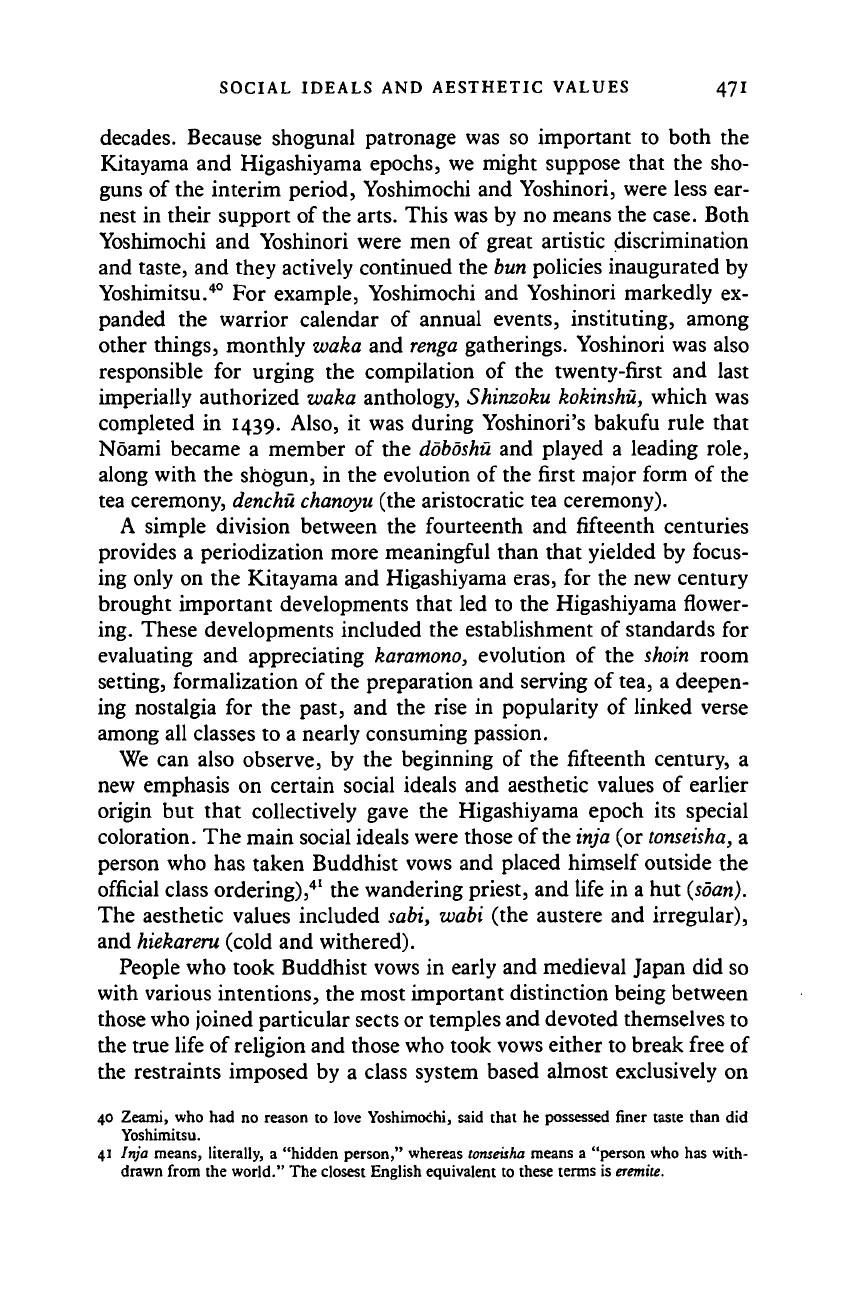
SOCIAL IDEALS AND AESTHETIC VALUES 471
decades. Because shogunal patronage was so important to both the
Kitayama and Higashiyama epochs, we might suppose that the sho-
guns of the interim period, Yoshimochi and Yoshinori, were less ear-
nest in their support of the arts. This was by no means the case. Both
Yoshimochi and Yoshinori were men of great artistic discrimination
and taste, and they actively continued the bun policies inaugurated by
Yoshimitsu.
40
For example, Yoshimochi and Yoshinori markedly ex-
panded the warrior calendar of annual events, instituting, among
other things, monthly waka and renga gatherings. Yoshinori was also
responsible for urging the compilation of the twenty-first and last
imperially authorized waka anthology, Shinzoku kokinshu, which was
completed in 1439. Also, it was during Yoshinori's bakufu rule that
Noami became a member of the dobdshu and played a leading role,
along with the shdgun, in the evolution of the first major form of the
tea ceremony, denchu chanqyu (the aristocratic tea ceremony).
A simple division between the fourteenth and fifteenth centuries
provides a periodization more meaningful than that yielded by focus-
ing only on the Kitayama and Higashiyama eras, for the new century
brought important developments that led to the Higashiyama flower-
ing. These developments included the establishment of standards for
evaluating and appreciating karamono, evolution of the shoin room
setting, formalization of the preparation and serving of tea, a deepen-
ing nostalgia for the past, and the rise in popularity of linked verse
among all classes to a nearly consuming passion.
We can also observe, by the beginning of the fifteenth century, a
new emphasis on certain social ideals and aesthetic values of earlier
origin but that collectively gave the Higashiyama epoch its special
coloration. The main social ideals were those of the inja (or
tonseisha,
a
person who has taken Buddhist vows and placed himself outside the
official class ordering),
41
the wandering priest, and life in a hut (soan).
The aesthetic values included sabi, wabi (the austere and irregular),
and hiekareru (cold and withered).
People who took Buddhist vows in early and medieval Japan did so
with various intentions, the most important distinction being between
those who joined particular sects or temples and devoted themselves to
the true life of religion and those who took vows either to break free of
the restraints imposed by a class system based almost exclusively on
40 Zeami, who had no reason to love Yoshimochi, said that he possessed finer taste than did
Yoshimitsu.
41 Inja means, literally, a "hidden person," whereas
tonseisha
means a "person who has with-
drawn from the world." The closest English equivalent to these terms is eremite.
Cambridge Histories Online © Cambridge University Press, 2008
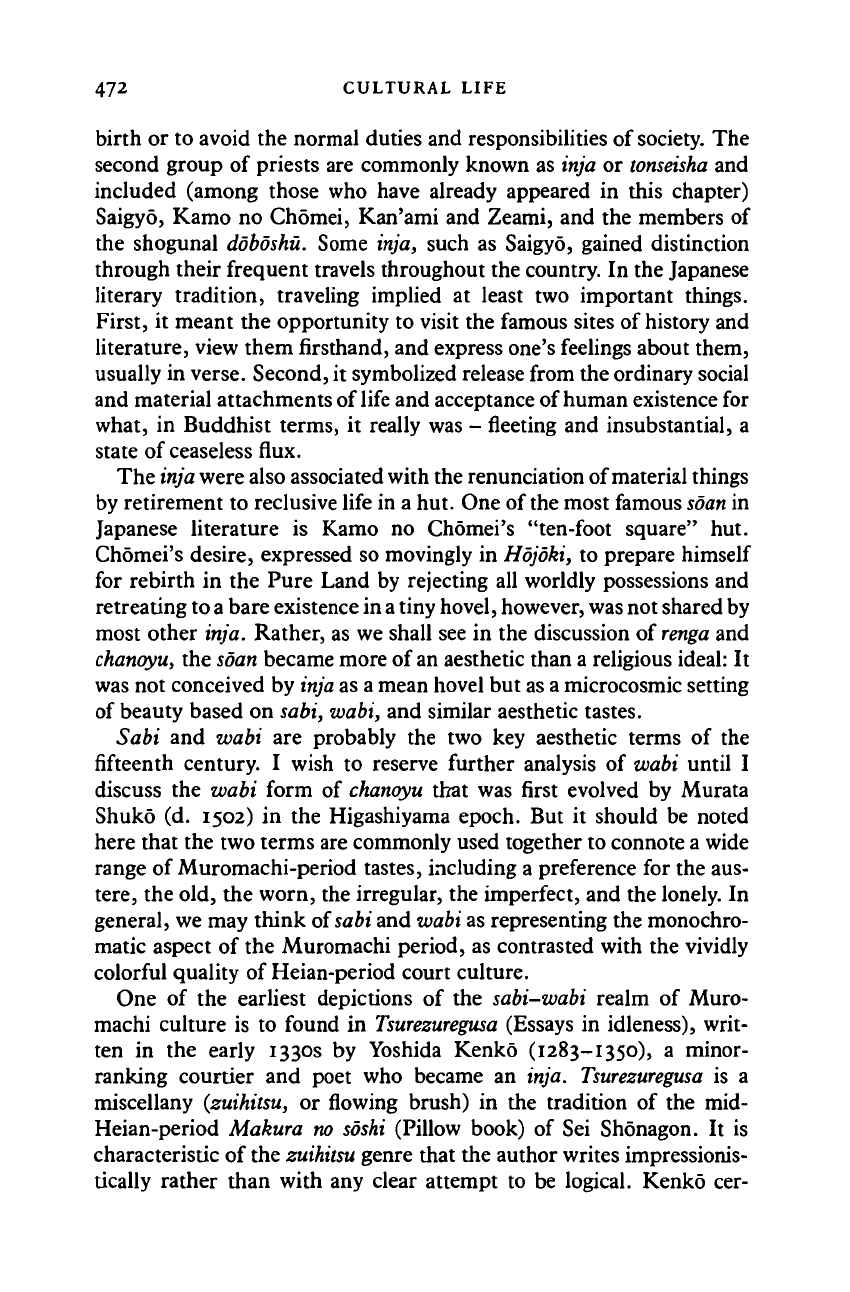
472 CULTURAL LIFE
birth or to avoid the normal duties and responsibilities of
society.
The
second group of priests are commonly known as inja or
tonseisha
and
included (among those who have already appeared in this chapter)
Saigyo, Kamo no Chomei, Kan'ami and Zeami, and the members of
the shogunal
doboshu.
Some inja, such as Saigyo, gained distinction
through their frequent travels throughout the country. In the Japanese
literary tradition, traveling implied at least two important things.
First, it meant the opportunity to visit the famous sites of history and
literature, view them firsthand, and express one's feelings about them,
usually in verse. Second, it symbolized release from the ordinary social
and material attachments of life and acceptance of human existence for
what, in Buddhist terms, it really was - fleeting and insubstantial, a
state of ceaseless flux.
The
inja
were also associated with the renunciation of material things
by retirement to reclusive life in a hut. One of
the
most famous
soan
in
Japanese literature is Kamo no Chomei's "ten-foot square" hut.
Chomei's desire, expressed so movingly in
Hojoki,
to prepare himself
for rebirth in the Pure Land by rejecting all worldly possessions and
retreating
to a
bare existence in
a
tiny hovel, however,
was
not shared by
most other inja. Rather, as we shall see in the discussion of
renga
and
chanoyu,
the
soan
became more of an aesthetic than a religious ideal: It
was not conceived by
inja
as
a
mean hovel but as
a
microcosmic setting
of beauty based on
sabi,
wabi, and similar aesthetic tastes.
Sabi and wabi are probably the two key aesthetic terms of the
fifteenth century. I wish to reserve further analysis of wabi until I
discuss the wabi form of
chanoyu
that was first evolved by Murata
Shuko (d. 1502) in the Higashiyama epoch. But it should be noted
here that the two terms are commonly used together to connote a wide
range of Muromachi-period tastes, including a preference for the aus-
tere,
the old, the worn, the irregular, the imperfect, and the lonely. In
general, we may think of
sabi
and
wabi
as representing the monochro-
matic aspect of the Muromachi period, as contrasted with the vividly
colorful quality of Heian-period court culture.
One of the earliest depictions of the sabi-wabi realm of Muro-
machi culture is to found in
Tsurezuregusa
(Essays in idleness), writ-
ten in the early 1330s by Yoshida Kenko (1283-1350), a minor-
ranking courtier and poet who became an inja.
Tsurezuregusa
is a
miscellany (zuihitsu, or flowing brush) in the tradition of the mid-
Heian-period Makura no
soshi
(Pillow book) of Sei Shonagon. It is
characteristic of the
zuihitsu
genre that the author writes impressionis-
tically rather than with any clear attempt to be logical. Kenko cer-
Cambridge Histories Online © Cambridge University Press, 2008
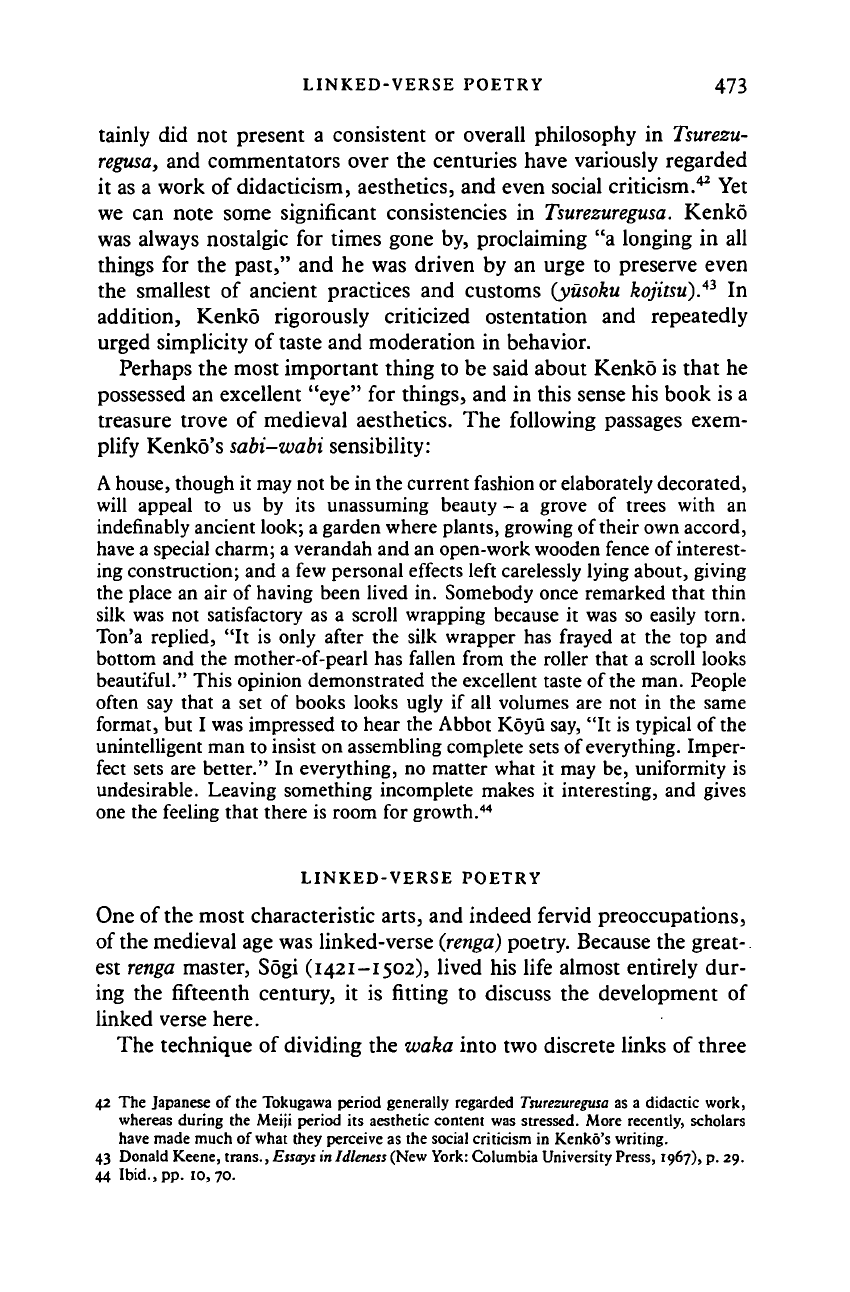
LINKED-VERSE POETRY 473
tainly did not present a consistent or overall philosophy in Tsurezu-
regusa, and commentators over the centuries have variously regarded
it as a work of didacticism, aesthetics, and even social criticism.
42
Yet
we can note some significant consistencies in Tsurezuregusa. Kenko
was always nostalgic for times gone by, proclaiming "a longing in all
things for the past," and he was driven by an urge to preserve even
the smallest of ancient practices and customs (yusoku kojitsu).** In
addition, Kenko rigorously criticized ostentation and repeatedly
urged simplicity of taste and moderation in behavior.
Perhaps the most important thing to be said about Kenko is that he
possessed an excellent "eye" for things, and in this sense his book is a
treasure trove of medieval aesthetics. The following passages exem-
plify Kenko's sabi-wabi sensibility:
A
house, though it may not be in the current fashion or elaborately decorated,
will appeal to us by its unassuming beauty - a grove of trees with an
indefinably ancient look; a garden where plants, growing of their own accord,
have a special charm; a verandah and an open-work wooden fence of interest-
ing construction; and a few personal effects left carelessly lying about, giving
the place an air of having been lived in. Somebody once remarked that thin
silk was not satisfactory as a scroll wrapping because it was so easily torn.
Ton'a replied, "It is only after the silk wrapper has frayed at the top and
bottom and the mother-of-pearl has fallen from the roller that a scroll looks
beautiful." This opinion demonstrated the excellent taste of the man. People
often say that a set of books looks ugly if all volumes are not in the same
format, but I was impressed to hear the Abbot Koyu say, "It is typical of the
unintelligent man to insist on assembling complete sets of everything. Imper-
fect sets are better." In everything, no matter what it may be, uniformity is
undesirable. Leaving something incomplete makes it interesting, and gives
one the feeling that there is room for growth.
44
LINKED-VERSE POETRY
One of the most characteristic arts, and indeed fervid preoccupations,
of the medieval age was linked-verse
(renga)
poetry. Because the great-
est renga master, Sogi (1421-1502), lived his life almost entirely dur-
ing the fifteenth century, it is fitting to discuss the development of
linked verse here.
The technique of dividing the waka into two discrete links of three
42 The Japanese of the Tokugawa period generally regarded
Tsurezuregusa
as a didactic work,
whereas during the Meiji period its aesthetic content was stressed. More recently, scholars
have made much of what they perceive as the social criticism in Kenko's writing.
43 Donald Keene, trans., Essays
in Idleness
(New York: Columbia University Press, 1967), p. 29.
44 Ibid., pp. 10,70.
Cambridge Histories Online © Cambridge University Press, 2008
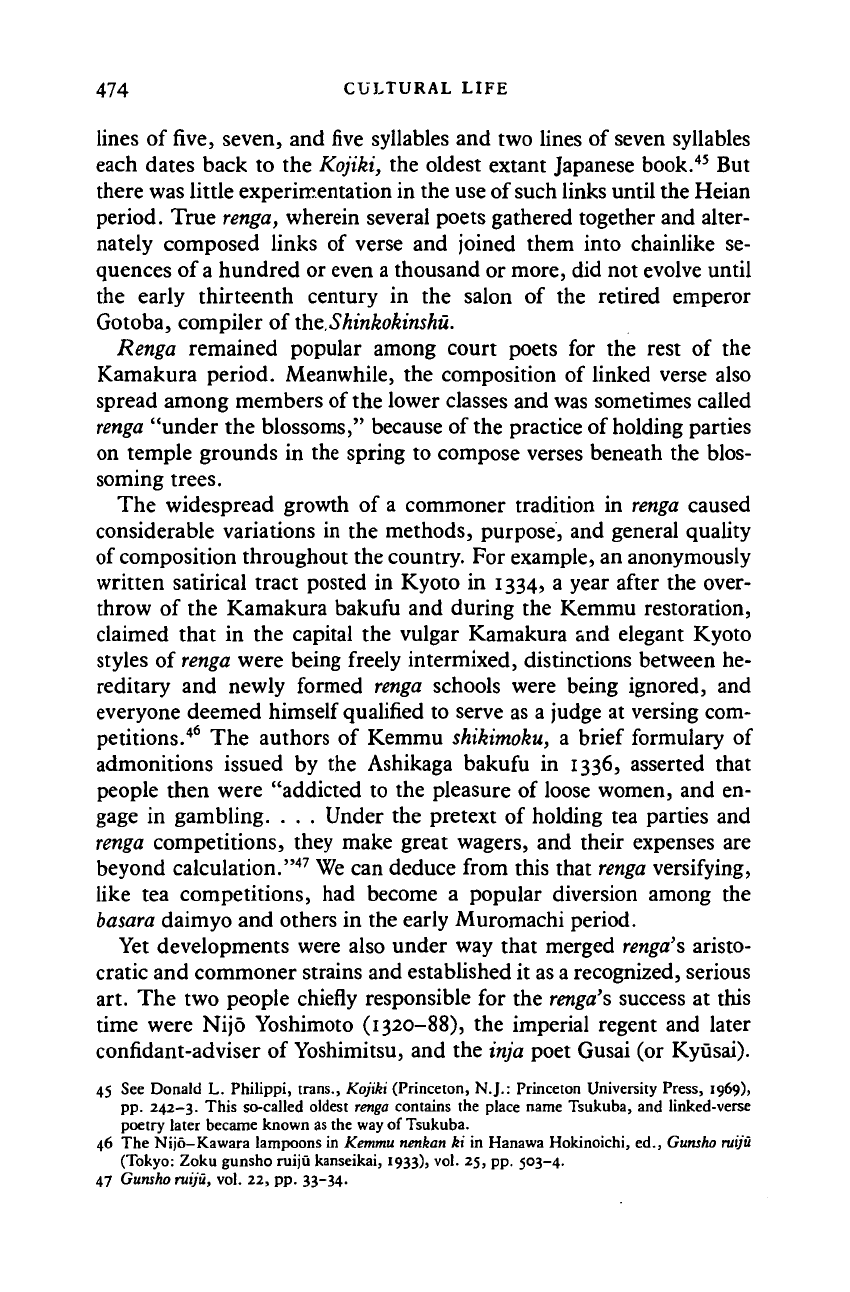
474 CULTURAL LIFE
lines of five, seven, and five syllables and two lines of seven syllables
each dates back to the Kojiki, the oldest extant Japanese book.
45
But
there was little experimentation in the use of such links until the Heian
period. True
renga,
wherein several poets gathered together and alter-
nately composed links of verse and joined them into chainlike se-
quences of
a
hundred or even a thousand or more, did not evolve until
the early thirteenth century in the salon of the retired emperor
Gotoba, compiler of
the.Shinkokinshu.
Renga remained popular among court poets for the rest of the
Kamakura period. Meanwhile, the composition of linked verse also
spread among members of the lower classes and was sometimes called
renga
"under the blossoms," because of the practice of holding parties
on temple grounds in the spring to compose verses beneath the blos-
soming trees.
The widespread growth of a commoner tradition in
renga
caused
considerable variations in the methods, purpose, and general quality
of composition throughout the country. For example, an anonymously
written satirical tract posted in Kyoto in 1334, a year after the over-
throw of the Kamakura bakufu and during the Kemmu restoration,
claimed that in the capital the vulgar Kamakura and elegant Kyoto
styles of
renga
were being freely intermixed, distinctions between he-
reditary and newly formed
renga
schools were being ignored, and
everyone deemed himself qualified to serve as a judge at versing com-
petitions.
46
The authors of Kemmu
shikimoku,
a brief formulary of
admonitions issued by the Ashikaga bakufu in 1336, asserted that
people then were "addicted to the pleasure of loose women, and en-
gage in gambling. . . . Under the pretext of holding tea parties and
renga
competitions, they make great wagers, and their expenses are
beyond calculation."
47
We can deduce from this that
renga
versifying,
like tea competitions, had become a popular diversion among the
basara
daimyo and others in the early Muromachi period.
Yet developments were also under way that merged
renga's
aristo-
cratic and commoner strains and established it as a recognized, serious
art. The two people chiefly responsible for the
renga's
success at this
time were Nijo Yoshimoto (1320-88), the imperial regent and later
confidant-adviser of Yoshimitsu, and the inja poet Gusai (or Kyusai).
45 See Donald L. Philippi, trans., Kojiki (Princeton, N.J.: Princeton University Press, 1969),
pp.
242-3. This so-called oldest renga contains the place name Tsukuba, and linked-verse
poetry later became known as the way of Tsukuba.
46 The Nijo-Kawara lampoons in Kemmu
nenkan
ki in Hanawa Hokinoichi, ed.,
Gunsho ruiju
(Tokyo: Zoku gunsho ruiju kanseikai, 1933), vol. 25, pp. 503-4.
47
Gunsho
ruiju, vol. 22, pp. 33-34.
Cambridge Histories Online © Cambridge University Press, 2008
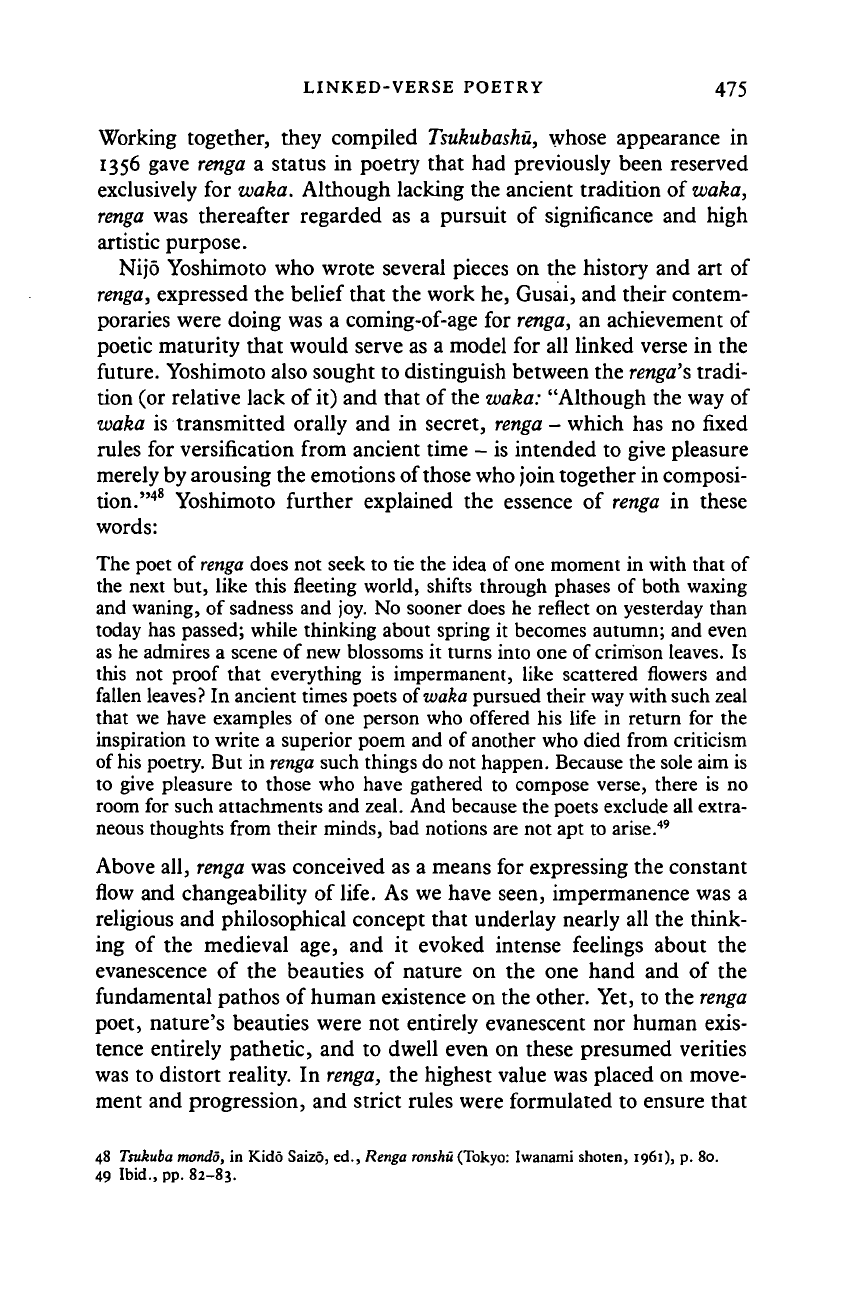
LINKED-VERSE POETRY 475
Working together, they compiled Tsukubashu, whose appearance in
1356 gave renga a status in poetry that had previously been reserved
exclusively for waka. Although lacking the ancient tradition of waka,
renga was thereafter regarded as a pursuit of significance and high
artistic purpose.
Nijo Yoshimoto who wrote several pieces on the history and art of
renga, expressed the belief that the work he, Gusai, and their contem-
poraries were doing was a coming-of-age for renga, an achievement of
poetic maturity that would serve as a model for all linked verse in the
future. Yoshimoto also sought to distinguish between the
renga's
tradi-
tion (or relative lack of it) and that of the waka: "Although the way of
waka is transmitted orally and in secret,
renga
- which has no fixed
rules for versification from ancient time - is intended to give pleasure
merely by arousing the emotions of those who join together in composi-
tion."
48
Yoshimoto further explained the essence of renga in these
words:
The poet of
renga
does not seek to tie the idea of one moment in with that of
the next but, like this fleeting world, shifts through phases of both waxing
and waning, of sadness and joy. No sooner does he reflect on yesterday than
today has passed; while thinking about spring it becomes autumn; and even
as he admires a scene of new blossoms it turns into one of crimson leaves. Is
this not proof that everything is impermanent, like scattered flowers and
fallen leaves? In ancient times poets of waka pursued their way with such zeal
that we have examples of one person who offered his life in return for the
inspiration to write a superior poem and of another who died from criticism
of his poetry. But in renga such things do not happen. Because the sole aim is
to give pleasure to those who have gathered to compose verse, there is no
room for such attachments and zeal. And because the poets exclude all extra-
neous thoughts from their minds, bad notions are not apt to arise.
49
Above all, renga was conceived as a means for expressing the constant
flow and changeability of life. As we have seen, impermanence was a
religious and philosophical concept that underlay nearly all the think-
ing of the medieval age, and it evoked intense feelings about the
evanescence of the beauties of nature on the one hand and of the
fundamental pathos of human existence on the other. Yet, to the
renga
poet, nature's beauties were not entirely evanescent nor human exis-
tence entirely pathetic, and to dwell even on these presumed verities
was to distort reality. In renga, the highest value was placed on move-
ment and progression, and strict rules were formulated to ensure that
48
Tsukuba
tnondo,
in Kido Saizo, ed., Renga
ronshu
(Tokyo: Iwanami shoten, 1961), p. 80.
49 Ibid., pp. 82-83.
Cambridge Histories Online © Cambridge University Press, 2008
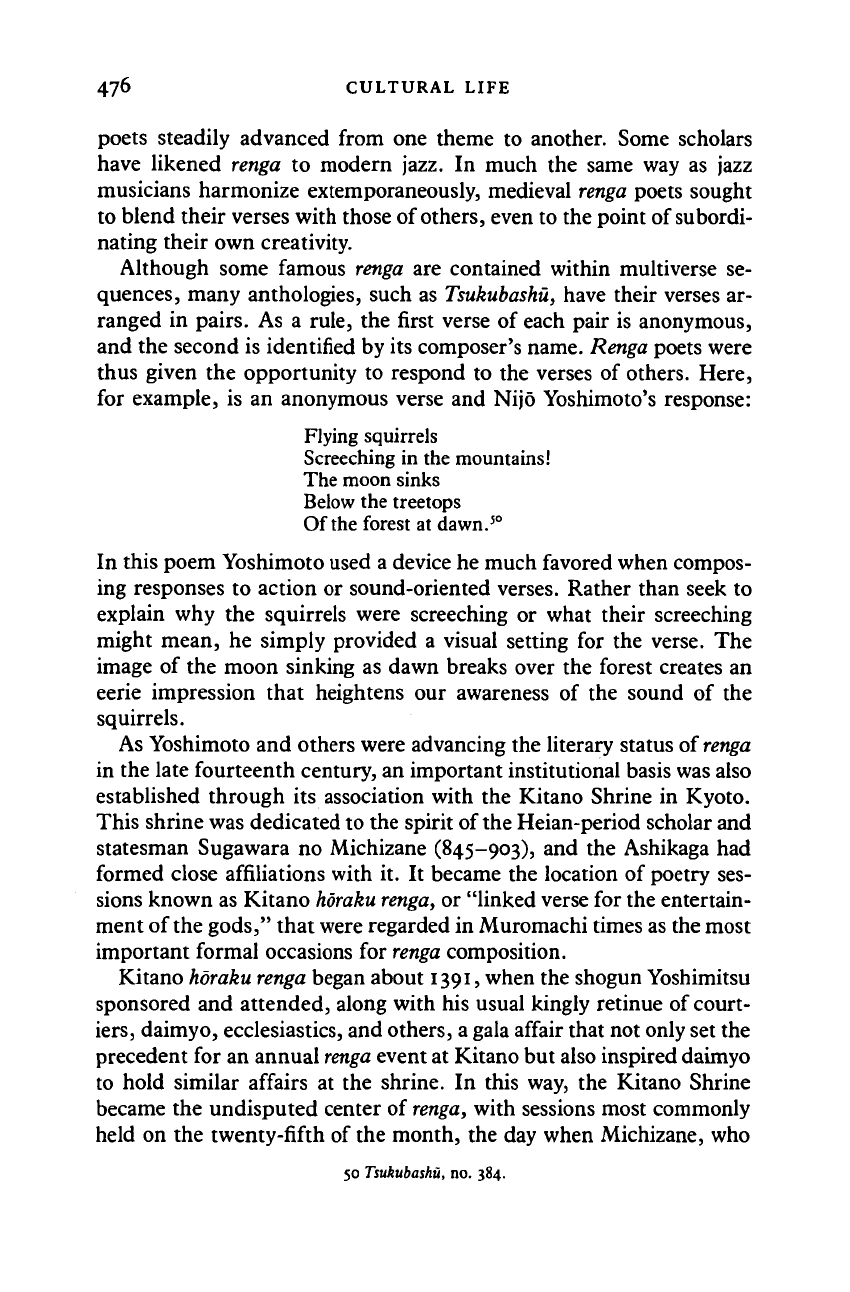
476 CULTURAL LIFE
poets steadily advanced from one theme to another. Some scholars
have likened renga to modern jazz. In much the same way as jazz
musicians harmonize extemporaneously, medieval renga poets sought
to blend their verses with those of
others,
even to the point of subordi-
nating their own creativity.
Although some famous renga are contained within multiverse se-
quences, many anthologies, such as Tsukubashu, have their verses ar-
ranged in pairs. As a rule, the first verse of each pair is anonymous,
and the second is identified by its composer's name. Renga poets were
thus given the opportunity to respond to the verses of others. Here,
for example, is an anonymous verse and Nijo Yoshimoto's response:
Flying squirrels
Screeching in the mountains!
The moon sinks
Below the treetops
Of
the
forest at dawn.
30
In this poem Yoshimoto used a device he much favored when compos-
ing responses to action or sound-oriented verses. Rather than seek to
explain why the squirrels were screeching or what their screeching
might mean, he simply provided a visual setting for the verse. The
image of the moon sinking as dawn breaks over the forest creates an
eerie impression that heightens our awareness of the sound of the
squirrels.
As Yoshimoto and others were advancing the literary status of
renga
in the late fourteenth century, an important institutional basis was also
established through its association with the Kitano Shrine in Kyoto.
This shrine was dedicated to the spirit of the Heian-period scholar and
statesman Sugawara no Michizane (845-903), and the Ashikaga had
formed close affiliations with it. It became the location of poetry ses-
sions known as Kitano horaku
renga,
or "linked verse for the entertain-
ment of the gods," that were regarded in Muromachi times as the most
important formal occasions for
renga
composition.
Kitano horaku renga began about
1391,
when the shogun Yoshimitsu
sponsored and attended, along with his usual kingly retinue of court-
iers,
daimyo, ecclesiastics, and others, a gala affair that not only set the
precedent for an annual
renga
event at Kitano but also inspired daimyo
to hold similar affairs at the shrine. In this way, the Kitano Shrine
became the undisputed center of
renga,
with sessions most commonly
held on the twenty-fifth of the month, the day when Michizane, who
50
Tsukubashu,
no. 384.
Cambridge Histories Online © Cambridge University Press, 2008
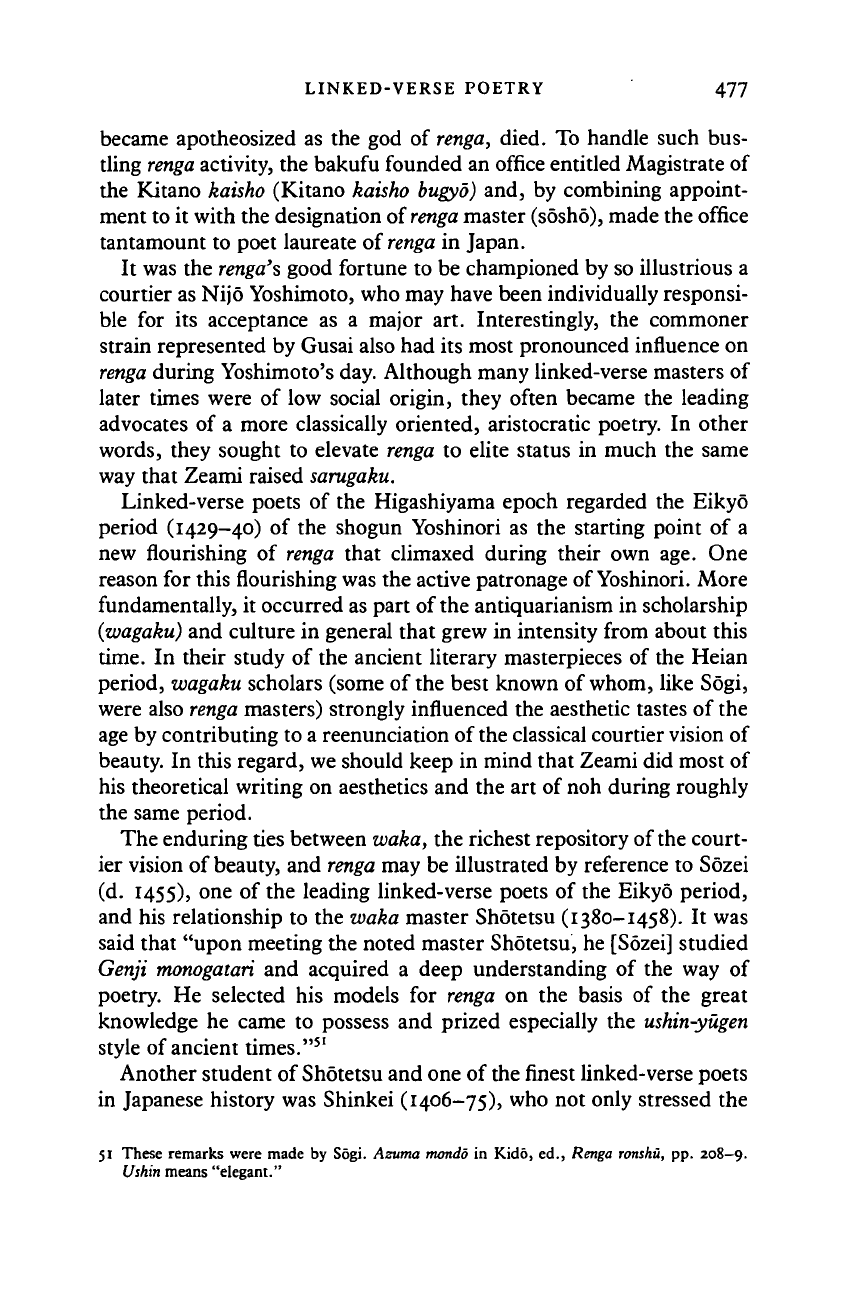
LINKED-VERSE POETRY 477
became apotheosized as the god of renga, died. To handle such bus-
tling
renga
activity, the bakufu founded an office entitled Magistrate of
the Kitano kaisho (Kitano kaisho bugyo) and, by combining appoint-
ment to it with the designation of
renga
master (sosho), made the office
tantamount to poet laureate of
renga
in Japan.
It was the renga's good fortune to be championed by so illustrious a
courtier as Nijo Yoshimoto, who may have been individually responsi-
ble for its acceptance as a major art. Interestingly, the commoner
strain represented by Gusai also had its most pronounced influence on
renga
during Yoshimoto's day. Although many linked-verse masters of
later times were of low social origin, they often became the leading
advocates of a more classically oriented, aristocratic poetry. In other
words, they sought to elevate renga to elite status in much the same
way that Zeami raised sarugaku.
Linked-verse poets of the Higashiyama epoch regarded the Eikyo
period (1429-40) of the shogun Yoshinori as the starting point of a
new flourishing of renga that climaxed during their own age. One
reason for this flourishing was the active patronage of Yoshinori. More
fundamentally, it occurred as part of the antiquarianism in scholarship
(wagaku) and culture in general that grew in intensity from about this
time.
In their study of the ancient literary masterpieces of the Heian
period, wagaku scholars (some of the best known of whom, like Sogi,
were also
renga
masters) strongly influenced the aesthetic tastes of the
age by contributing to a reenunciation of the classical courtier vision of
beauty. In this regard, we should keep in mind that Zeami did most of
his theoretical writing on aesthetics and the art of noh during roughly
the same period.
The enduring ties between waka, the richest repository of the court-
ier vision of beauty, and
renga
may be illustrated by reference to Sozei
(d. 1455), one of the leading linked-verse poets of the Eikyo period,
and his relationship to the waka master Shotetsu (1380-1458). It was
said that "upon meeting the noted master Shotetsu, he [Sozei] studied
Genji monogatari and acquired a deep understanding of the way of
poetry. He selected his models for renga on the basis of the great
knowledge he came to possess and prized especially the ushin-yugen
style of ancient times."
51
Another student of Shotetsu and one of the finest linked-verse poets
in Japanese history was Shinkei (1406-75), who not only stressed the
51 These remarks were made by Sogi. Azuma mondo in Kido, ed., Renga ronshu, pp. 208-9.
Ushin means "elegant."
Cambridge Histories Online © Cambridge University Press, 2008
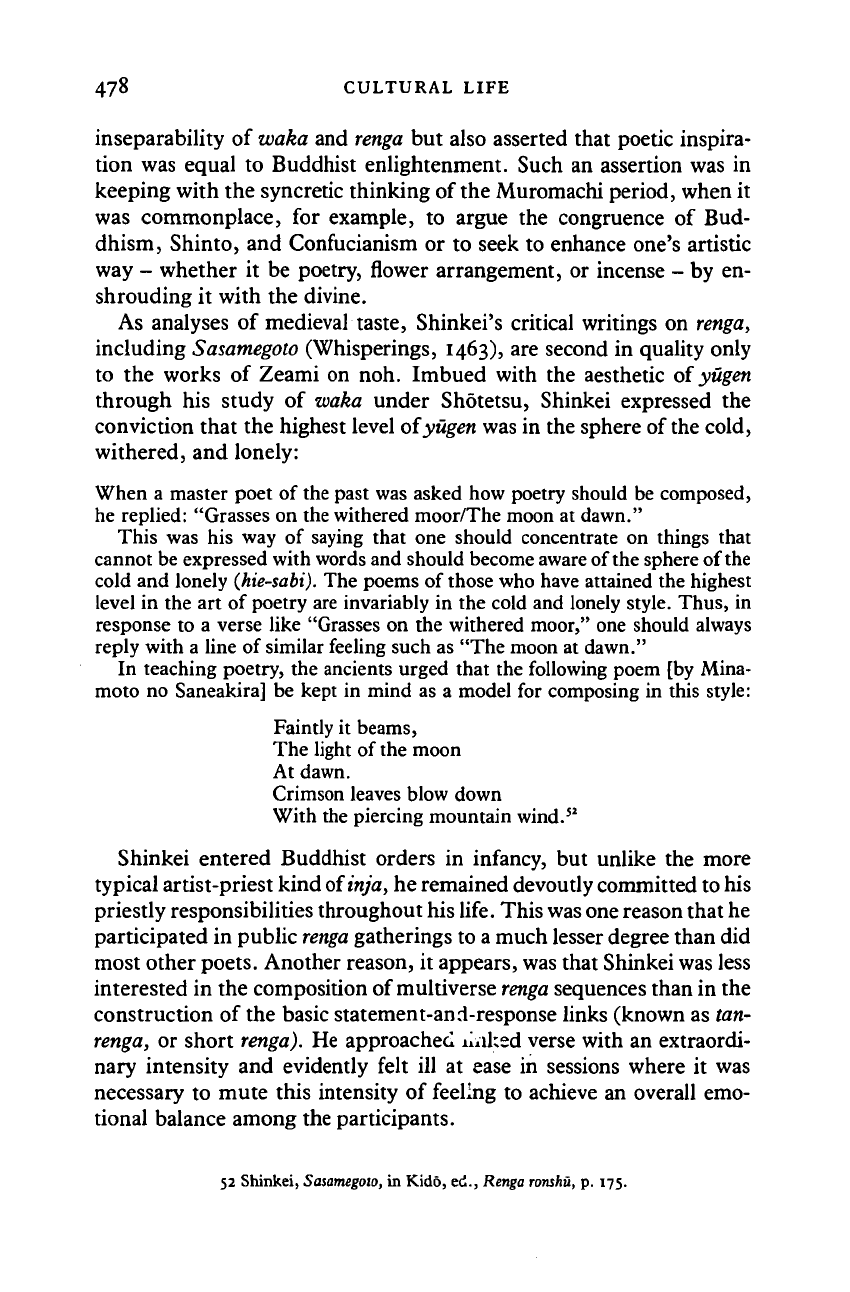
478 CULTURAL LIFE
inseparability of waka and renga but also asserted that poetic inspira-
tion was equal to Buddhist enlightenment. Such an assertion was in
keeping with the syncretic thinking of the Muromachi period, when it
was commonplace, for example, to argue the congruence of Bud-
dhism, Shinto, and Confucianism or to seek to enhance one's artistic
way - whether it be poetry, flower arrangement, or incense - by en-
shrouding it with the divine.
As analyses of medieval taste, Shinkei's critical writings on renga,
including Sasamegoto (Whisperings, 1463), are second in quality only
to the works of Zeami on noh. Imbued with the aesthetic of yugen
through his study of waka under Shotetsu, Shinkei expressed the
conviction that the highest level of yugen was in the sphere of the cold,
withered, and lonely:
When a master poet of the past was asked how poetry should be composed,
he replied: "Grasses on the withered moor/The moon at dawn."
This was his way of saying that one should concentrate on things that
cannot be expressed with words and should become aware of the sphere of the
cold and lonely
(kie-sabi).
The poems of those who have attained the highest
level in the art of poetry are invariably in the cold and lonely style. Thus, in
response to a verse like "Grasses on the withered moor," one should always
reply with a line of similar feeling such as "The moon at dawn."
In teaching poetry, the ancients urged that the following poem [by Mina-
moto no Saneakira] be kept in mind as a model for composing in this style:
Faintly it beams,
The light of the moon
At dawn.
Crimson leaves blow down
With the piercing mountain wind.
52
Shinkei entered Buddhist orders in infancy, but unlike the more
typical artist-priest kind of inja, he remained devoutly committed to his
priestly responsibilities throughout his life. This was one reason that he
participated in public
renga
gatherings to a much lesser degree than did
most other poets. Another reason, it appears, was that Shinkei was less
interested in the composition of multiverse
renga
sequences than in the
construction of the basic statement-and-response links (known as tan-
renga, or short renga). He approached naked verse with an extraordi-
nary intensity and evidently felt ill at ease in sessions where it was
necessary to mute this intensity of feeling to achieve an overall emo-
tional balance among the participants.
52 Shinkei,
Sasamegoto,
in Kido, ed., Renga
ronshu,
p. 175.
Cambridge Histories Online © Cambridge University Press, 2008
